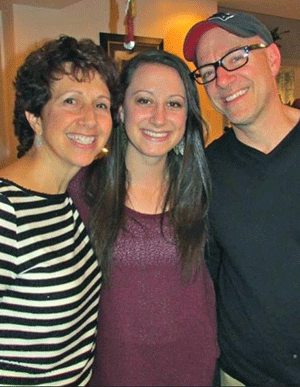 While myasthenia gravis can strike at any age, it’s not as common in children – only one in 10 cases are diagnosed in children under 10 – and symptoms may present differently than in adults.1 Because of this, young people with MG face an especially difficult time getting an accurate diagnosis.
While myasthenia gravis can strike at any age, it’s not as common in children – only one in 10 cases are diagnosed in children under 10 – and symptoms may present differently than in adults.1 Because of this, young people with MG face an especially difficult time getting an accurate diagnosis.
Emily Boyle was only 14 when she began exhibiting symptoms.
“She mentioned to me that she was having trouble smiling,” says Emily’s mom, Betsy. “I thought it was weird, but I kind of ignored it.”
Over the next several weeks, Emily’s difficulty moving her facial muscles became more and more noticeable to her family. Betsy took her to the pediatrician, who immediately referred them to a pediatric neurologist. That doctor – and others they saw that spring – were stumped.
After a volley of tests to rule out more common diseases and disorders, her doctors began to suspect MG.
She was started on Mestinon, a common MG medication to combat muscle weakness. The medication helped control her symptoms, but they didn’t go away entirely.
“I don’t feel that I was impacted that much because I was so young,” shares Emily. “Except numbness in my bottom lip — I wanted to be able to smile. I wanted to feel more normal. I remember a lot of people looking at me and trying to figure out what was wrong.”
By the time she started high school that fall, her symptoms had worsened dramatically and were impacting her quality of life. It became hard for her to eat and talk, as she lost control of the muscles in her face, jaw, and throat. If she got a cold, she’d struggle to breathe because she couldn’t cough.
Betsy and her husband, Tom, began a deep-dive into MG, exploring every corner of the internet in their quest to help Emily. In their online travels, they found MGFA and its resources and supports.
“I remember reading little stories and realizing more what myasthenia was,” says Emily. “I did a lot more research, and it was eye opening to see that all of these other people have myasthenia. To me, it was comforting.”
Finding Treatment
 Betsy and Tom called specialist after specialist trying to find a treatment that would work for Emily.
Betsy and Tom called specialist after specialist trying to find a treatment that would work for Emily.
“I was making calls all over the place trying to get appointments with people,” says Betsy.
After several months of searching, Emily secured an appointment at Johns Hopkins Medicine in Baltimore, Maryland. The experts there were able to conduct a same-day test on site to definitively confirm Emily’s diagnosis.
Their neurologist recommended increasing Emily’s Mestinon dosage and undergoing a thymectomy, which is the surgical removal of the thymus. This gland plays a role in the production of antibodies and, when producing antibodies beyond childhood, can trigger myasthenia. Removing the thymus has improved symptoms in some patients and is a strategy for long-term disease remission.
Her parents were nervous, as any parent would be when considering surgery for their child. Betsy says their doctor convinced them that this approach would give Emily the best chance of dramatically reducing or even eliminating her symptoms.
“I was very relieved when we got to Baltimore,” Emily says. “I was ready to get the surgery and move on.”
Her surgery went well, and within just a few days she was able to be discharged. While Emily remembers the pain and discomfort of recovery, she also remembers feeling more like herself within a few weeks.
The surgery and continuing on Mestinon for several years made a huge difference in Emily’s symptoms. She is now in remission and no longer on medications.
“The thymectomy changed everything for the better. I would highly recommend it.”
Emily is now a high school Spanish teacher and spends her days standing in her classroom, talking to her students — a career that might have been impossible without this life-changing treatment.
Betsy agrees.
“It was a remarkable godsend that we will forever be grateful for and we can’t express in words,” she says.
“We’re eager to give back in some way now, including supporting MGFA and trying to make it easier for newly diagnosed patients to learn more about thymectomy. It changed the whole course of Emily’s life. It’s worth pursuing and asking multiple neurologists about it.”
1 – Source: https://www.chop.edu/conditions-diseases/myasthenia-gravis

